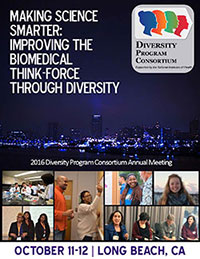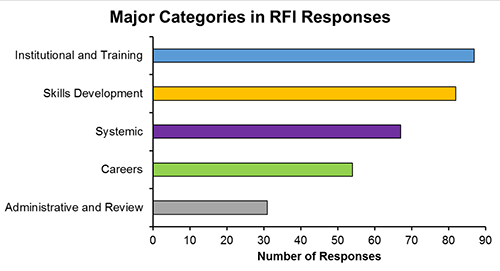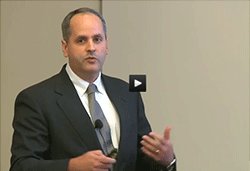If you develop or use software for structure-based drug design or generate data on drug target structures and ligand affinities, you may be interested in the Drug Design Data Resource (D3R)  . This is an NIGMS-funded project to collect and share high-quality protein-ligand data sets, develop computer-aided drug design workflows, and engage the community through blind prediction challenges.
. This is an NIGMS-funded project to collect and share high-quality protein-ligand data sets, develop computer-aided drug design workflows, and engage the community through blind prediction challenges.
The D3R, hosted by the University of California, San Diego, continues a program initiated by NIGMS under the Community Structure-Activity Resource (CSAR) at the University of Michigan. A goal of this program has been to gather previously unpublished data from the pharmaceutical industry and other sources and to make it available for validating and improving software for predicting ligand poses and interaction energies. Several data sets have already been donated by companies, including Genentech, AbbVie, GlaxoSmithKline, and Vertex, as well as by academic groups. Both resources have also generated data sets internally or in collaboration with academia.
The data sets, which contain X-ray crystal structures of protein-ligand complexes and structure/activity data for multiple series of ligands, represent 13 different drug targets, including most recently for HSP90, MAP4K4, and designed steroid and vitamin D binding proteins. D3R has also collected data on host-guest systems and made this data available as part of the SAMPL  series of challenges for benchmarking software predictions of “simple” small-molecule chemical properties such as solvation free energy, partition coefficients, and binding to hydrophobic cavities.
series of challenges for benchmarking software predictions of “simple” small-molecule chemical properties such as solvation free energy, partition coefficients, and binding to hydrophobic cavities.
Building on the success of its 1st Annual D3R Workshop  , in which the 2015 Grand Challenge
, in which the 2015 Grand Challenge  was discussed and summarized in a report, D3R just announced the 2016 Grand Challenge
was discussed and summarized in a report, D3R just announced the 2016 Grand Challenge  . It is based on structures of the Farnesoid X receptor (FXR) and runs through February 2, 2017.
. It is based on structures of the Farnesoid X receptor (FXR) and runs through February 2, 2017.
The resource also has developed a Continuous Evaluation of Ligand Pose Prediction  (CELPP) series of tests in collaboration with the World Wide Protein Databank
(CELPP) series of tests in collaboration with the World Wide Protein Databank  (wwPDB) and the Research Collaboratory for Structural Bioinformatics
(wwPDB) and the Research Collaboratory for Structural Bioinformatics  (RCSB), another resource supported by NIGMS. The CELPP tests, which are distinct from the Grand Challenge, will provide chemical compound identifiers of bound small molecules in addition to the protein polymer sequence five days before release of 3D coordinates, giving developers an opportunity to predict docked poses each week.
(RCSB), another resource supported by NIGMS. The CELPP tests, which are distinct from the Grand Challenge, will provide chemical compound identifiers of bound small molecules in addition to the protein polymer sequence five days before release of 3D coordinates, giving developers an opportunity to predict docked poses each week.
D3R and its predecessor CSAR were developed to meet the needs of the drug design community identified during workshops several years ago. Continued community input and participation, including additional data donations, are important to help D3R fulfill its mission. Data releases can be coordinated with publication in other formats and venues. Contact D3R principal investigators Rommie Amaro and/or Michael Gilson or send email to drugdesigndata@gmail.com to see how you can be involved.
 After attending the Diversity Program Consortium (DPC)
After attending the Diversity Program Consortium (DPC)  annual meeting in mid-October and learning about the progress the consortium has made and its future plans, we’re feeling energized as we begin the third year of this grant. The DPC, supported by the NIH Common Fund and managed by NIGMS, is a cooperative agreement focused on finding the best ways to improve research training and mentoring in the biomedical sciences and on engaging a more diverse field of individuals in biomedical research careers. The consortium includes three interconnected programs: Building Infrastructure Leading to Diversity (BUILD), the National Research Mentoring Network (NRMN) and the Coordination and Evaluation Center (CEC).
annual meeting in mid-October and learning about the progress the consortium has made and its future plans, we’re feeling energized as we begin the third year of this grant. The DPC, supported by the NIH Common Fund and managed by NIGMS, is a cooperative agreement focused on finding the best ways to improve research training and mentoring in the biomedical sciences and on engaging a more diverse field of individuals in biomedical research careers. The consortium includes three interconnected programs: Building Infrastructure Leading to Diversity (BUILD), the National Research Mentoring Network (NRMN) and the Coordination and Evaluation Center (CEC).

 I’m pleased to announce that Stephanie Constant will be joining us in early 2017 as the new chief of our Office of Scientific Review.
I’m pleased to announce that Stephanie Constant will be joining us in early 2017 as the new chief of our Office of Scientific Review.
